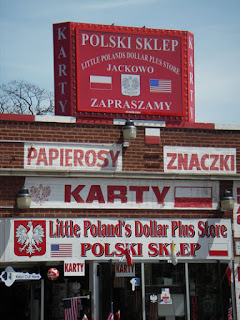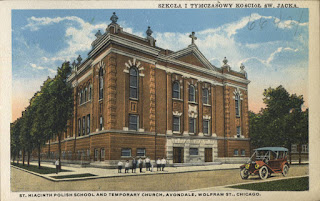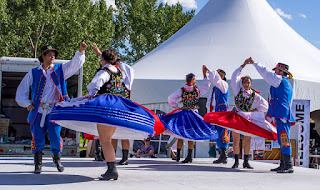By Weronica Dabros
Weronica Dabros was a senior majoring in Integrative Biology and minoring in Polish when she wrote this blog post in 418 ‘Language and Minorities in Europe’ in spring 2019. She was planning on applying to dental schools to continue her career in health.
They have been named the za chlebem (“For Bread”) migrants from a damaged country. They are the land hungry immigrants; the peasants, the censored, the opportunists. They are the low-skilled wage laborers. They are, as far as their origins in this country are concerned, the Polish of Chicago.
In the 19th century, Chicago was a growing city with industrial companies that provided many immigrants with greater opportunities to achieve their own ‘American Dream’. With the influx of various immigrants from Eastern Europe in the 1890’s, Chicago lured more Poles than any American city (Radzialowski 1976). Chicago became ‘Poland elsewhere’ beyond the borders of the Republic of Poland. Consequently, the Polish have made a significant impact on the culture, landscape and success of industrial Chicago. They have slowly made their way up from the peasantry of Poland to the urban working class of America.
So, what was the cause of this immense wave of Polish immigrants into the land of economic opportunities - the land of industrial Chicago? There was a period of time where Poland was removed from the European map and was not considered a distinct political entity. The Polish were deprived of their country, language and cultural expression. The Republic of Poland has endured a very complex and rich history that in some cases required the Poles to emigrate out of their home country to search for better opportunities for freedom, land ownership, status, education and lifestyle. The initial place of landing for the Poles was the south side of Chicago in the Back of the Yards neighborhood. Over time, the Polish neighborhoods shifted from the Back of the Yards to Humboldt Park/Logan Square and eventually up to the Belmont Cragin/Portage Park area where the majority of Polish people live today.
Throughout the displacement, Polish communities have continued to maintain their culture and traditions. These Chicago neighborhoods flourished with Polish culture, music, and food because the Poles were finally able to express themselves culturally without political repression and government censorship unlike in their homeland. The many institutions such as churches, grocery stores, and Polish schools allowed the Polish people to continue to be active members of their national and ethnic customs in the neighborhoods they occupied.
One of the most popular Polish neighborhoods was located in Avondale and was named Jackowo, best known as “Little Poland”. This area was a hotspot for the Polish community in the late 1900’s, so much so, that if you were a passenger on the CTA (Chicago Transit Authority) taking the Milwaukee bus up North, the bus driver would regularly announce "YATS-KO-VO" over the loudspeaker as the next destination (LaTrace, 2016). There was a strip of Polish businesses such as bakeries, restaurants, churches, and pharmacies where Polish presence was unmistakable. The Poles came to Chicago with nothing but a suitcase and their hopes for opportunity and turned bitter lemons into sweet “cytrynówka”, a Polish lemon liqueur.
As the Polish community grew like red poppies (Poland’s national flower) in the garden that was Chicago, they established various institutions that are still used to this day. One of the many institutions is the Polish Museum of America, established in 1935 and located in Chicago’s West Town area. It holds a compilation of Polish artifacts such as art, embroidery, and folk costumes. The museum organizes frequent exhibitions to maintain remembrance of Polish origins and educate the public on Polish history and culture.
Additionally, there are 15 Polish parishes located in Chicago that are still fully functioning today. These parishes are combined with Polish ethnic Saturday schools where language and cultural maintenance is accomplished. Students in Polish schools are taught Polish history, grammar, literature, and geography, as well as religion. These Polish schools are held from preschool to the third level of high school. At the end of the students’ junior year, they are required to pass a written Matura (“exit exam”) on their knowledge of Polish history, grammar, geography and literature. Students must also successfully complete an oral presentation about a topic relating to Polish history in front of a committee. Afterwards, students receive a diploma and close the chapter of their lives that has provided them with a deeper connection to their Polish roots and stronger sense of nationalism.
Many religious holidays are also maintained due to the presence of the Polish churches in Chicago. Wigilia (“Christmas Eve dinner”) and Wigilia Mass, containing 12 vegetarian dishes, is still held in the majority of households, and the majority of Poles still attend Pasterka (midnight mass) before Christmas Day. Orszak Trzech Króli, a procession from one Polish parish to another through the streets of Chicago to honor Three Kings day followed by Mass, is still held in some parishes. Around Easter time, Poles create extravagant palms to be blessed on Palm Sunday. There are many religious traditions that are more common in Poland but do take place in Chicago due to the large Polish population and their dedication to Catholicism.
Modern Chicago has significantly changed since the industrial era and the Polish community has evolved along with it. Various cultural events and traditions are held in dedication to Polish immigrants who continue to create a life for themselves in the growing city.
An annual Polish Constitution Day Parade is held in downtown Chicago as the Polonia of Chicago march down the streets to display their morphological Polszczyzna (the connection of Poles to their state language) and their Polska duma (“Polish pride”). All 35 Polish ethnic schools in Illinois take place in the parade hosted in Chicago in order to represent the diaspora of Poles throughout the state of Illinois. In addition, Zespół Wici (Chicago based Polish Folk Dance Company) performs Poland’s rich folk dance and presents its colorful folk costumes amongst the sky-high buildings of downtown.
A cultural event called “Taste of Polonia” also takes place yearly at Copernicus Center as the Poles of Chicago along with other members of the community gather to share a weekend of pierogi, piwo (beer), music and dancing.
Just last year in May, the president of the Republic of Poland, Andrzej Duda traveled to Chicago to announce Polish Heritage Day (May 19th) in Millenium Park. The park was filled with the Polish community and even attracted some Poles living in areas outside of Chicago. It is clear that even in Poland and cities outside of Chicago, the city of Chicago is recognized as one of the greatest epicenters of Polish culture and history.
Being Polish in Chicago has created a foundation for Polish Americans to maintain their Polish roots and nurture their language by creating a community. This community provided Polish immigrants that were forced to leave their motherland for a chance at a better life with a second home and more opportunities for the future generations of Polish immigrants.
Citations:
Latrace, AJ. 2016. The People's Guide to Avondale, Chicago's Polish Village. Curbed Chicago. https://chicago.curbed.com/2016/4/12/11414228/chicago-avondale-neighborhood-guide-polish-village
Radzialowski, T. 1976. The Competition for Jobs and Racial Stereotypes: Poles and Blacks in Chicago. Polish American Studies 33(2): 5-18.
Weronica Dabros was a senior majoring in Integrative Biology and minoring in Polish when she wrote this blog post in 418 ‘Language and Minorities in Europe’ in spring 2019. She was planning on applying to dental schools to continue her career in health.
They have been named the za chlebem (“For Bread”) migrants from a damaged country. They are the land hungry immigrants; the peasants, the censored, the opportunists. They are the low-skilled wage laborers. They are, as far as their origins in this country are concerned, the Polish of Chicago.
 |
| Chicago 1950 (Source: wikimedia commons) |
So, what was the cause of this immense wave of Polish immigrants into the land of economic opportunities - the land of industrial Chicago? There was a period of time where Poland was removed from the European map and was not considered a distinct political entity. The Polish were deprived of their country, language and cultural expression. The Republic of Poland has endured a very complex and rich history that in some cases required the Poles to emigrate out of their home country to search for better opportunities for freedom, land ownership, status, education and lifestyle. The initial place of landing for the Poles was the south side of Chicago in the Back of the Yards neighborhood. Over time, the Polish neighborhoods shifted from the Back of the Yards to Humboldt Park/Logan Square and eventually up to the Belmont Cragin/Portage Park area where the majority of Polish people live today.
 |
| Polish Village (source: wikimedia commons) |
One of the most popular Polish neighborhoods was located in Avondale and was named Jackowo, best known as “Little Poland”. This area was a hotspot for the Polish community in the late 1900’s, so much so, that if you were a passenger on the CTA (Chicago Transit Authority) taking the Milwaukee bus up North, the bus driver would regularly announce "YATS-KO-VO" over the loudspeaker as the next destination (LaTrace, 2016). There was a strip of Polish businesses such as bakeries, restaurants, churches, and pharmacies where Polish presence was unmistakable. The Poles came to Chicago with nothing but a suitcase and their hopes for opportunity and turned bitter lemons into sweet “cytrynówka”, a Polish lemon liqueur.
As the Polish community grew like red poppies (Poland’s national flower) in the garden that was Chicago, they established various institutions that are still used to this day. One of the many institutions is the Polish Museum of America, established in 1935 and located in Chicago’s West Town area. It holds a compilation of Polish artifacts such as art, embroidery, and folk costumes. The museum organizes frequent exhibitions to maintain remembrance of Polish origins and educate the public on Polish history and culture.
 | ||
| St. Hyacinth Polish School and Temporary Church, Avondale, Wolfram St., Chicago (Source: Wikimedia Commons) |
 |
| Wigilia (source: Wikimedia Commons) |
Modern Chicago has significantly changed since the industrial era and the Polish community has evolved along with it. Various cultural events and traditions are held in dedication to Polish immigrants who continue to create a life for themselves in the growing city.
 |
| Polish Day Parade (source: Wikimedia Commons) |
 |
| Polish dancing (source: Flickr) |
Just last year in May, the president of the Republic of Poland, Andrzej Duda traveled to Chicago to announce Polish Heritage Day (May 19th) in Millenium Park. The park was filled with the Polish community and even attracted some Poles living in areas outside of Chicago. It is clear that even in Poland and cities outside of Chicago, the city of Chicago is recognized as one of the greatest epicenters of Polish culture and history.
Being Polish in Chicago has created a foundation for Polish Americans to maintain their Polish roots and nurture their language by creating a community. This community provided Polish immigrants that were forced to leave their motherland for a chance at a better life with a second home and more opportunities for the future generations of Polish immigrants.
Citations:
Latrace, AJ. 2016. The People's Guide to Avondale, Chicago's Polish Village. Curbed Chicago. https://chicago.curbed.com/2016/4/12/11414228/chicago-avondale-neighborhood-guide-polish-village
Radzialowski, T. 1976. The Competition for Jobs and Racial Stereotypes: Poles and Blacks in Chicago. Polish American Studies 33(2): 5-18.
Comments
Post a Comment
The moderators of the Linguis Europae blog reserve the right to delete any comments that they deem inappropriate. This may include, but is not limited to, spam, racist or disrespectful comments about other cultures/groups or directed at other commenters, and explicit language.